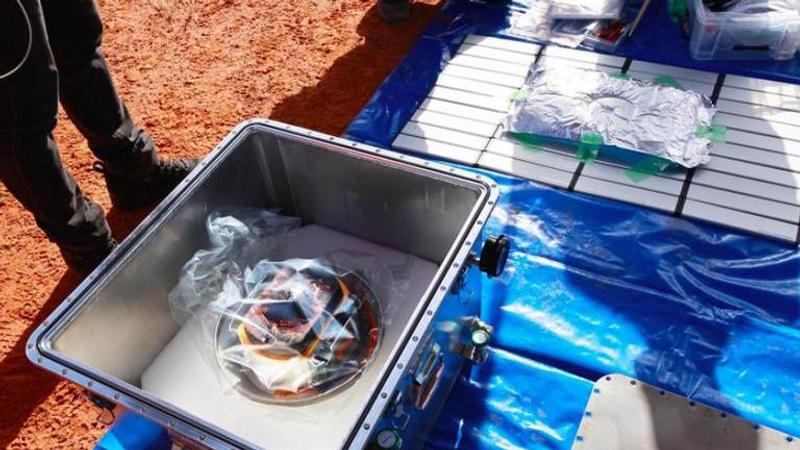Published 05:33 IST, December 7th 2020
Japan researchers excited to analyse asteroid Ryugu soil sample from 'Hayabusa2' capsule
A project sub-manager, Satoru Nakazawa said that the team will pack the capsule in a container and bring it to Japan this week to explore the "treasure inside".

Advertisement
Japan’s Aerospace Exploration Agency (JAXA) on December 6 said the Japanese researchers were excited about the return of the capsule delivered by Japan's Hayabusa2 spacecraft. The capsule that landed at Woomera Prohibited Area (WPA), Australia is carrying soil from distant a asteroid Ryugu.
JAXA said in a press release that the capsule recovery team is set to extract gas out of the capsule at the operational headquarters and explore the "treasure inside”. The spacecraft returned after a six-year mission with the sample and can help scientists explore the origin of the solar system and life on Earth.
A project sub-manager, Satoru Nakazawa told AP that the team will pack the capsule in a container and bring it to Japan this week. Meanwhile, the Hayabusa2 project manager at the Japan Aerospace Exploration Agency informed that the Japansese space officials were able to land the "treasure box" safely onto the sparsely populated Australian desert. Yuichi Tsuda told AP that the capsule was in perfect shape and the team was looking forward to opening it. The capsule will be packed after its preliminary treatment at an Australian lab, Satoru Nakazawa, a project sub-manager said in a news conference.
Make sure to watch the @JAXA_en #Hayabusa2 post-recovery press conference via the below YouTube link.
— Australian Space Agency (@AusSpaceAgency) December 6, 2020
Live streaming will commence at 6:30PM (AEDT)! https://t.co/JEAoT5Vagp@haya2e_jaxa
We found the capsule!
— HAYABUSA2@JAXA (@haya2e_jaxa) December 5, 2020
Together with the parachute!
Wow!
(Collection Team M)#Hayabusa2#はやぶさ2#AsteroidExplorerHayabusa2 #HAYA2Report
This is from the office of Japan’s Prime Minister; thank you for the tweet! It is due to the support of so many people that we were able to come so far. We would like to continue to aim for new technology & science. Thank you once again,
— HAYABUSA2@JAXA (@haya2e_jaxa) December 6, 2020
Hayabusa2 Project https://t.co/SQzpIEP6ux
Capsule collection! The helicopter team immediately flew to the location identified by the DFS team. They searched for the fallen capsule by using radio waves and maps. Thank you very much!
— HAYABUSA2@JAXA (@haya2e_jaxa) December 6, 2020
(Collection Team M)#Hayabusa2#はやぶさ2#AsteroidExplorerHayabusa2 #HAYA2Report pic.twitter.com/KSyEbnU3Yd
Spacecraft to target 1998 KY26
"We take this opportunity to show our deepest gratitude to the governments of Australia and Japan, NASA, and relevant parties for their cooperation in the recovery of the 'Hayabusa2' re-entry capsule," JAXA said in a press release. The Hayabusa2 spacecraft is expected to work on an extended mission of targeting two new asteroids. It will be moving towards its first target, 1998 KY26, which is a ball-shaped asteroid with a diameter of 30 metres. Hayabusa2 reached the Ryugu asteroid in June 2018 and descended on the asteroid’s surface in February 2019. It then fired a small projectile into the ground and scooping surface material into a container to bring it back to Earth.
Samples are on their way for analysis at the Woomera Test Range. @haya2e_jaxa @AusAirForce @DeptDefence #Hayabusa2 https://t.co/eBIukNPTgu pic.twitter.com/AK0C7TCArk
— Australian Space Agency (@AusSpaceAgency) December 6, 2020
Live from Woomera: @haya2e_jaxa press conference, watch👇 https://t.co/JEAoT5Vagp pic.twitter.com/ceRhAn665B
— Australian Space Agency (@AusSpaceAgency) December 6, 2020
(Image Credit: Twitter/@haya2e_jaxa)
05:33 IST, December 7th 2020



